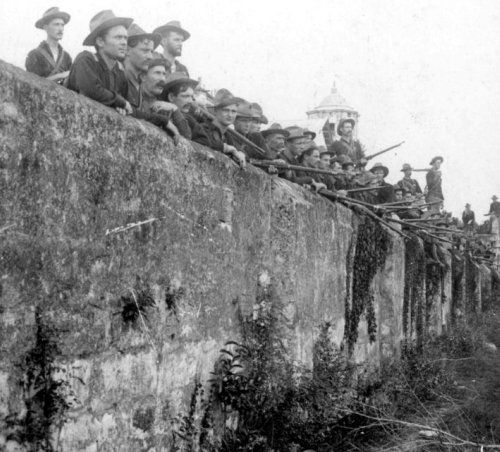Soldiers of the Philippine Expeditionary Force stand behind a cemetery wall waiting for an insurgent attack in 1899 during the Philippine-American War.
As a follow-up to Commodore George Dewey’s naval victory over the Spanish squadron in the Philippines in the Battle of Manila Bay on May 1, 1898, President William McKinley directed that an expeditionary force be sent to the islands. On May 3, commanding general of the army Major General Nelson A. Miles initially recommended to Secretary of War Russell A. Alger the dispatch there of a mixed force of regulars and volunteers, composed of some 5,000 infantry, cavalry, and artillery troops.
Major General Wesley Merritt, veteran of the American Civil War and the Indian Wars and the second-ranking general in the army, was appointed to command the expeditionary force, which was designated VIII Corps. Major General Elwell S. Otis, like Merritt another veteran of the Civil War and Indian Wars, was named its second-in-command. Although the War Department subsequently increased the strength of the expeditionary force to 20,000 men, Merritt argued for a stronger representation of regulars in this force than Miles was willing to allot. Furthermore, Merritt believed that his assignment embraced the entire Philippine archipelago, whereas Miles saw only the city of Manila and its port facilities as the objective. The fact that the army’s two ranking soldiers differed to such an extent with regard to the expedition’s role underscores the ambiguity surrounding the U. S. mission in the Philippines, about which President McKinley had been vague at best. In any event, a mixed force of 5,000 regulars and 15,000 volunteers was earmarked for VIII Corps.
San Francisco was the VIII Corps assembly and embarkation point. The troops were assigned to Camp Merritt, near Golden Gate Park. Because Merritt was busy in Washington, D. C., Otis had charge of preparing the expeditionary corps for departure. As the various regiments arrived there, they were issued weapons and supplies and given training in simulated battle exercises. In contrast to the confusion experienced by V Corps at Tampa, Florida, which was then sent to Cuba, preparations at San Francisco proceeded relatively smoothly.
Troops being sent to the Philippines knew little or nothing about the islands. It took several months for the Office of Military Information to distribute its sourcebook, Military Notes on the Philippines. In the meantime, the War Department provided such information as was available, including at least one encyclopedia article.
Because the U. S. Navy had bought up most of the available shipping and because the Cuban theater of war had priority, there were insufficient numbers of transports available to accommodate Merritt’s entire command in one lift, so VIII Corps had to be divided into three contingents. The first, consisting of 115 officers and 2,386 enlisted men under Brigadier General Thomas M. Anderson, sailed on May 25, 1898. After more than a month at sea, they arrived in Manila Bay on June 30. They were immediately put to work unloading supplies at Cavite and establishing camps. A second group, consisting of 158 officers and 3,404 enlisted men under Brigadier General Francis V. Greene, departed on June 15 and arrived in the Philippines on July 17. The third and largest contingent, 198 officers and 4,642 enlisted men under Brigadier General Arthur MacArthur and accompanied by Merritt, sailed on June 27 and arrived at its destination on July 25. The total of these three forces was 10,946 officers and men, all members of VIII Corps, arrived in the Philippines before the capture of Manila.
Merritt’s first task was to secure Manila. This First Battle of Manila occurred on August 13, although Merritt was unaware that Spain and the United States had agreed to the Protocol of Peace the previous day. At his own request, Merritt was relieved of command in the autumn of 1898 because of ill health, and command of the Philippine Expeditionary Force devolved to Otis. Initially, Otis was faced with the difficult task of maintaining peace and order among recalcitrant Filipino revolutionaries who resented the U. S. presence in their islands.
When war broke out between the United States and the Filipino Republican Army, headed by Emilio Aguinaldo y Famy, in February 1899, Otis had to deal not only with Aguinaldo but also increasingly disgruntled U. S. volunteers. Once the war with Spain ended, these volunteers, who had been mustered into federal service to fight Spain, saw no reason to remain in the Philippines and fight a war against Filipino insurgents. Eventually, the volunteers were shipped back to the United States and replaced with U. S. volunteer regiments recruited specifically for the Philippine fighting. The Philippine Expeditionary Force that sailed from San Francisco in the early summer of 1898 had undergone an almost complete transformation by early 1900.
